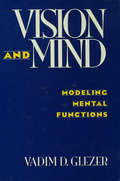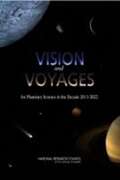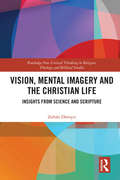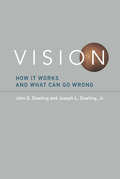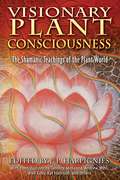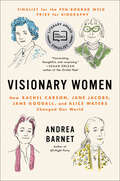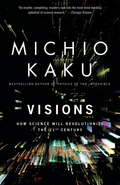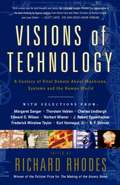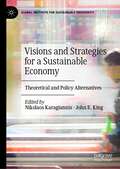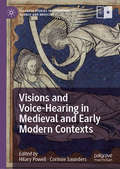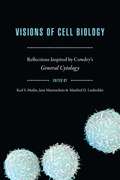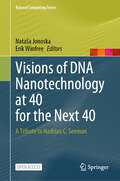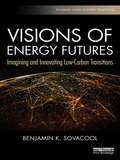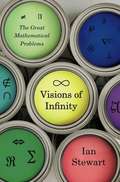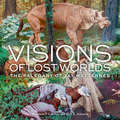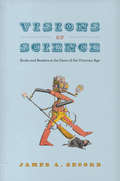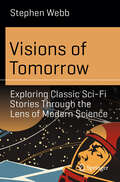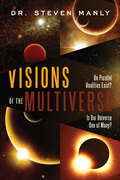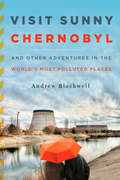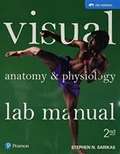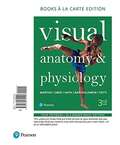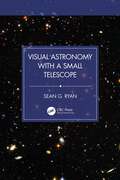- Table View
- List View
Vision and Light: Investigating Animal Eyes, Investigation Notebook
by The Lawrence Hall of ScienceNIMAC-sourced textbook
Vision and Mind: Modeling Mental Functions
by Vadim D. GlezerThe usual method for studying mental processes entails taking words in linguistics -- or concepts in logic -- and establishing the connections and relationships between them. Thus, the traditional approach to semantic problems -- those of meaning and understanding -- is through language. Most researchers agree that thought and language are generated by deep-seated semantic structures determined by the structure of the brain. Until now, however, all attempts at constructing semantic models have been made on the basis of linguistic material alone, without taking brain structure into account. Analysis of these models shows them to be as inadequate as those based on the method of the black box. This book approaches the problem of the organization of higher psychological functions a different way -- by analyzing the functional organization of the neural structures that gradually form universal categories from "raw" sensory material. At the higher levels of the brain's operation, these universals correspond to the basic categories of thought and language. The visual system provides rewarding material for such an approach, both because it is relatively well researched and because it is the main source of sensory information in humans. With this in mind, this monograph examines the whole process of the transformation and description -- the coding of visual information. The most important aspect of this process is the transition from the description of visual space to the description of individual objects and the relationships between them. This transition is made possible by the existence in the visual system of various mechanisms that developed during evolution as a result of environmental influences. Written for a wide circle of investigators in disciplines associated with different aspects of the functioning of the brain -- physiologists and psychologists -- this book is also of importance to engineers and mathematicians working on the problems of artificial intelligence, and linguists and philosophers interested in the deep structures that form the universals of thought and language.
Vision and Voyages for Planetary Science in the Decade 2013-2022
by Committee on the Planetary Science Decadal SurveyIn recent years, planetary science has seen a tremendous growth in new knowledge. Deposits of water ice exist at the Moon's poles. Discoveries on the surface of Mars point to an early warm wet climate, and perhaps conditions under which life could have emerged. Liquid methane rain falls on Saturn's moon Titan, creating rivers, lakes, and geologic landscapes with uncanny resemblances to Earth's. Vision and Voyages for Planetary Science in the Decade 2013-2022 surveys the current state of knowledge of the solar system and recommends a suite of planetary science flagship missions for the decade 2013-2022 that could provide a steady stream of important new discoveries about the solar system. Research priorities defined in the report were selected through a rigorous review that included input from five expert panels. NASA's highest priority large mission should be the Mars Astrobiology Explorer Cacher (MAX-C), a mission to Mars that could help determine whether the planet ever supported life and could also help answer questions about its geologic and climatic history. Other projects should include a mission to Jupiter's icy moon Europa and its subsurface ocean, and the Uranus Orbiter and Probe mission to investigate that planet's interior structure, atmosphere, and composition. For medium-size missions, Vision and Voyages for Planetary Science in the Decade 2013-2022 recommends that NASA select two new missions to be included in its New Frontiers program, which explores the solar system with frequent, mid-size spacecraft missions. If NASA cannot stay within budget for any of these proposed flagship projects, it should focus on smaller, less expensive missions first. Vision and Voyages for Planetary Science in the Decade 2013-2022 suggests that the National Science Foundation expand its funding for existing laboratories and establish new facilities as needed. It also recommends that the program enlist the participation of international partners. This report is a vital resource for government agencies supporting space science, the planetary science community, and the public.
Vision and Voyages for Planetary Science in the Decade 2013-2022
by National Research CouncilIn recent years, planetary science has seen a tremendous growth in new knowledge. Deposits of water ice exist at the Moon's poles. Discoveries on the surface of Mars point to an early warm wet climate, and perhaps conditions under which life could have emerged. Liquid methane rain falls on Saturn's moon Titan, creating rivers, lakes, and geologic landscapes with uncanny resemblances to Earth's. Vision and Voyages for Planetary Science in the Decade 2013-2022 surveys the current state of knowledge of the solar system and recommends a suite of planetary science flagship missions for the decade 2013-2022 that could provide a steady stream of important new discoveries about the solar system. Research priorities defined in the report were selected through a rigorous review that included input from five expert panels. NASA's highest priority large mission should be the Mars Astrobiology Explorer Cacher (MAX-C), a mission to Mars that could help determine whether the planet ever supported life and could also help answer questions about its geologic and climatic history. Other projects should include a mission to Jupiter's icy moon Europa and its subsurface ocean, and the Uranus Orbiter and Probe mission to investigate that planet's interior structure, atmosphere, and composition. For medium-size missions, Vision and Voyages for Planetary Science in the Decade 2013-2022 recommends that NASA select two new missions to be included in its New Frontiers program, which explores the solar system with frequent, mid-size spacecraft missions. If NASA cannot stay within budget for any of these proposed flagship projects, it should focus on smaller, less expensive missions first. Vision and Voyages for Planetary Science in the Decade 2013-2022 suggests that the National Science Foundation expand its funding for existing laboratories and establish new facilities as needed. It also recommends that the program enlist the participation of international partners. This report is a vital resource for government agencies supporting space science, the planetary science community, and the public.
Vision, Mental Imagery and the Christian Life: Insights from Science and Scripture (Routledge New Critical Thinking in Religion, Theology and Biblical Studies)
by Zoltán DörnyeiThis book uniquely explores how the notion of vision is presented in modern science and the Bible, and how it can be applied to contemporary Christian contexts. The word "vision", our ability to see, has been described by an increasing body of scholarship in the social sciences as our capacity for mental imagery and imagination. As such, this unique cognitive capability has been utilised in many fields for a variety of purposes, from arts and psychotherapy to politics and business management, and even for performance enhancement in sports. The current book argues that a better understanding of vision can have far-reaching practical implications for Christian life and ministry by helping people to align themselves with God’s specific purposes. After a theoretical overview that integrates scientific and theological insights, the final chapters present a variety of strategies that can help believers to discern God’s call through the use of mental imagery and then to develop and cultivate the perceived vision. The book examines the scientific and biblical principles of vision in a comprehensive manner, with a special emphasis on the practical implications of the issue. As such, it will be of great interest to scholars of Theology, Biblical Studies and Church Growth/Leadership, as well as Organisational Behaviour, Business Management and Psychology.
Vision: How It Works and What Can Go Wrong
by John E. Dowling Joseph L. DowlingDescriptions of basic visual mechanisms and related clinical abnormalities, by a neuroscientist and an ophthalmologist.Over the past fifty years, enormous progress has been made in understanding visual mechanisms and treating eye disorders. And yet the scientist is not always aware of the latest clinical advances and the clinician is often not up to date on the basic scientific discoveries. Writing in nontechnical language, John and Joseph Dowling, a neuroscientist and an ophthalmologist, examine vision from both perspectives, providing concise descriptions of basic visual mechanisms and related clinical abnormalities. Thus, an account of the photoreceptors is followed by a consideration of retinitis pigmentosa and macular degeneration; an explanation of the retina's function is followed by details of glaucoma and diabetic retinopathy.The authors begin with the cornea and lens, which project an image on the light-sensitive elements inside the eye, the photoreceptors, and how that process can be compromised by such disorders as cataracts and corneal disease. They go on to describe, among other things, how the photoreceptors capture light; retinal and visual cortical anatomy and physiology; and higher level visual processing that leads to perception. Cortical disorders such as amblyopia are discussed as well as specific deficits such as the inability to recognize faces, colors, or moving objects. Finally, they survey the evolution of our knowledge of vision, and speculate about future advances.
Visionary Plant Consciousness: The Shamanic Teachings of the Plant World
by J. P. Harpignies23 leading experts reveal the ways that psychoactive plants allow nature’s “voice” to speak to humans and what this communication means for our future • Presents the specific “human-plant interconnection” revealed by visionary plants • Explores the relevance of plant-induced visions and shamanic teachings to humanity’s environmental crisis • With contributions from Terence McKenna, Andrew Weil, Wade Davis, Michael Pollan, Alex Grey, Jeremy Narby, Katsi Cook, John Mohawk, Kat Harrison, and others Visionary plants have long served indigenous peoples and their shamans as enhancers of perception, thinking, and healing. These plants can also be important guides to the reality of the natural world and how we can live harmoniously in it. In Visionary Plant Consciousness, editor J. P. Harpignies has gathered presentations from the Bioneers annual conference of environmental and social visionaries that explore how plant consciousness affects the human condition. Twenty-three leading ethnobotanists, anthropologists, medical researchers, and cultural and religious figures such as Terence McKenna, Andrew Weil, Wade Davis, Michael Pollan, Alex Grey, Jeremy Narby, Katsi Cook, John Mohawk, and Kat Harrison, among others, present their understandings of the nature of psychoactive plants and their significant connection to humans. What they reveal is that these plants may help us access the profound intelligence in nature--the “mind of nature”--that we must learn to understand in order to survive our ecologically destructive way of life.
Visionary Women: How Rachel Carson, Jane Jacobs, Jane Goodall, and Alice Waters Changed Our World
by Andrea BarnetAndrea Barnet’s Visionary Women explores how Jane Jacobs, Rachel Carson, Jane Goodall, and Alice Waters spearheaded the modern progressive movement.Winner of The Green Prize for Sustainable LiteratureA Finalist for the PEN/Bograd Weld Prize for BiographyThis is the story of four influential women who profoundly shaped the world we live in today. Together, these women—linked not by friendship or field, but by their choice to break with convention—showed what one person speaking truth to power can do. Jane Jacobs fought for livable cities and strong communities; Rachel Carson warned us about poisoning the environment; Jane Goodall demonstrated the indelible kinship between humans and animals; and Alice Waters urged us to reconsider what and how we eat. With a keen eye for historical detail, Andrea Barnet traces the arc of each woman’s career and explores how their work collectively changed the course of history. While they hailed from different generations, Carson, Jacobs, Goodall, and Waters found their voices in the early sixties. At a time of enormous upheaval, all four stood as bulwarks against 1950s corporate culture and its war on nature. Consummate outsiders, each prevailed against powerful and mostly male adversaries while also anticipating the disaffections of the emerging counterculture.All told, their efforts ignited a transformative progressive movement while offering people a new way to think about the world and a more positive way of living in it.“These four gave their moment—and ours—a unique and compelling way to perceive the interconnections within a society, as well as its relationship to its surroundings.” —Bill McKibben, The Nation
Visions
by Michio KakuIn Visions, physicist and author Michio Kaku examines the great scientific revolutions that have dramatically reshaped the twentieth century--the quantum mechanics, biogenetics, and artificial intelligence--and shows how they will change and alter science and the way we live.The next century will witness more far-reaching scientific revolutions, as we make the transition from unraveling the secrets of nature to becoming masters of nature. We will no longer be passive bystanders to the dance of the universe, but will become creative choreographers of matter, life, and intelligence.The first section of Visions presents a shocking look at a cyber-world infiltrated by millions of tiny intelligence systems. Part two illustrates how the decoding of DNA's genetic structure will allow humans the "godlike ability to manipulate life almost at will." Finally, VISIONS focuses on the future of quantum physics, in which physicists will perfect new ways to manipulate matter and harness the cosmic energy of the universe.What makes Michio Kaku's vision of the science of the future so compelling--and so different from the mere forecasts of most thinkers--is that it is based on the groundbreaking research taking place in labs today, as well as the consensus of over 150 of Kaku's scientific colleagues. Science, for all its breathtaking change, evolves slowly; we can accurately predict, asserts Kaku, what the direction of science will be, based on the paths that are being forged today.A thrilling, unique narrative that brings together the thinking of many of the world's most accomplished scientists to explore the world of the future, Visions is science writing at its best.From the Trade Paperback edition.
Visions Of Technology: A Century Of Vital Debate About Machines Systems A
by Richard RhodesTechnology was the blessing and the bane of the twentieth century. Human life span nearly doubled in the West, but in no century were more human beings killed by new technologies of war. Improvements in agriculture now feed increasing billions, but pesticides and chemicals threaten to poison the earth. Does technology improve us or diminish us? Enslave us or make us free? With this first-ever collection of the essential twentieth-century writings on technology, Pulitzer Prize-winning historian Richard Rhodes explores the optimism, ambivalence, and wrongheaded judgments with which Americans have faced an ever-shifting world.Visions of Technology collects writings on events from the Great Exposition of 1900 and the invention of the telegraph to the advent of genetic counseling and the defeat of Garry Kasparov by IBM's chess-playing computer, Deep Blue. Its gems of opinion and history include Henry Ford on the horseless carriage, Robert Caro on the transformation of New York City, J. Robert Oppenheimer on science and war, Loretta Lynn on the Pill and much more. Together, they chronicle an unprecedented century of change.
Visions and Strategies for a Sustainable Economy: Theoretical and Policy Alternatives (Global Institute for Sustainable Prosperity)
by Nikolaos Karagiannis John E. KingThe multidisciplinary edited book Visions and Strategies for a Sustainable Economy: Theoretical and Policy Alternatives provides a thorough examination – at the theoretical and, especially, policy levels – of a number of key topics related to a sustainable economy and a better society. With important contributions by distinguished academics, the book presents alternative views, provides an assessment of contemporary realities in an era of ecological emergency, and offers visions, strategies, and realistic policies towards a better economy and society while paying special attention to a “green new deal” for different areas.
Visions and Voice-Hearing in Medieval and Early Modern Contexts (Palgrave Studies in Literature, Science and Medicine)
by Corinne Saunders Hilary PowellThis book examines how the experiences of hearing voices and seeing visions were understood within the cultural, literary, and intellectual contexts of the medieval and early modern periods. In the Middle Ages, these experiences were interpreted according to frameworks that could credit visionaries or voice-hearers with spiritual knowledge, and allow them to inhabit social roles that were as much desired as feared. Voice-hearing and visionary experience offered powerful creative possibilities in imaginative literature and were often central to the writing of inner, spiritual lives. Ideas about such experience were taken up and reshaped in response to the cultural shifts of the early modern period. These essays, which consider the period 1100 to 1700, offer diverse new insights into a complex, controversial, and contested category of human experience, exploring literary and spiritual works as illuminated by scientific and medical writings, natural philosophy and theology, and the visual arts. In extending and challenging contemporary bio-medical perspectives through the insights and methodologies of the arts and humanities, the volume offers a timely intervention within the wider project of the medical humanities. Chapters 2 and 5 are available open access under a Creative Commons Attribution 4.0 International License via link.springer.com.
Visions of Cell Biology: Reflections Inspired by Cowdry's "General Cytology"
by Manfred D. LaubichlerAlthough modern cell biology is often considered to have arisen following World War II in tandem with certain technological and methodological advances—in particular, the electron microscope and cell fractionation—its origins actually date to the 1830s and the development of cytology, the scientific study of cells. By 1924, with the publication of Edmund Vincent Cowdry’s General Cytology, the discipline had stretched beyond the bounds of purely microscopic observation to include the chemical, physical, and genetic analysis of cells. Inspired by Cowdry’s classic, watershed work, this book collects contributions from cell biologists, historians, and philosophers of science to explore the history and current status of cell biology. Despite extraordinary advances in describing both the structure and function of cells, cell biology tends to be overshadowed by molecular biology, a field that developed contemporaneously. This book remedies that unjust disparity through an investigation of cell biology’s evolution and its role in pushing forward the boundaries of biological understanding. Contributors show that modern concepts of cell organization, mechanistic explanations, epigenetics, molecular thinking, and even computational approaches all can be placed on the continuum of cell studies from cytology to cell biology and beyond. The first book in the series Convening Science: Discovery at the Marine Biological Laboratory, Visions of Cell Biology sheds new light on a century of cellular discovery.
Visions of DNA Nanotechnology at 40 for the Next 40: A Tribute to Nadrian C. Seeman (Natural Computing Series)
by Nataša Jonoska Erik WinfreeThis open access book provides a unique and state-of-the-art view on DNA nanotechnology with an eye toward future developments. Intended as a tribute to Nadrian C. Seeman, who founded the field of DNA nanotechnology, the content is an exciting mixture of technical and non-technical material, reviews, tutorials, perspectives, new findings, and open questions. The book aims to inspire current researchers to sit back and think about the big picture, while also enticing new researchers to enter the field. Most of all, the book captures voices from a unique moment in time: 40 years after the publication of the first paper that envisioned DNA nanotechnology.From this vantage point, what are the untold stories, the unspoken concerns, the underlying fundamental issues, the overlooked opportunities, and the unifying grand challenges? What will help us see more clearly, see more creatively, or see farther? What is transpiring right now that could pave the way for the future? To address these questions, leading researchers have contributed 22 chapters, grouped into five sections: perspectives, chemistry and physics, structures, biochemical circuits, and spatial systems.This book will be an important reference point in the field of DNA nanotechnology, both for established researchers looking to take stock of the field and its future, and for newcomers such as graduate students and researchers in other fields who are beginning to appreciate the power and applicability of its methods.
Visions of Energy Futures: Imagining and Innovating Low-Carbon Transitions (Routledge Studies in Energy Transitions)
by Benjamin K. SovacoolThis book examines the visions, fantasies, frames, discourses, imaginaries, and expectations associated with six state-of-the-art energy systems—nuclear power, hydrogen fuel cells, shale gas, clean coal, smart meters, and electric vehicles—playing a key role in current deliberations about low-carbon energy supply and use. Visions of Energy Futures: Imagining and Innovating Low-Carbon Transitions unveils what the future of energy systems could look like, and how their meanings are produced, often alongside moments of contestation. Theoretically, it analyzes these technological case studies with emerging concepts from various disciplines: utopianism (history of technology), symbolic convergence (communication studies), technological frames (social construction of technology), discursive coalitions (discourse analysis and linguistics), sociotechnical imaginaries (science and technology studies), and the sociology of expectations (innovation studies, future studies). It draws from these cases to create a synthetic set of dichotomies and frameworks for energy futures based on original data collected across two global epistemic communities— nuclear physicists and hydrogen engineers—and experts in Eastern Europe and the Nordic region, stakeholders in South Africa, and newspapers in the United Kingdom. This book is motivated by the premise that tackling climate change via low-carbon energy systems and practices is one of the most significant challenges of the twenty-first century, and that success will require not only new energy technologies, but also new ways of understanding language, visions, and discursive politics. The discursive creation of the energy systems of tomorrow are propagated in polity, hoping to be realized as the material fact of the future, but processed in conflicting ways with underlying tensions as to how contemporary societies ought to be ordered. This book will be essential reading for students and scholars of energy policy, energy and environment, and technology assessment.
Visions of Infinity: The Great Mathematical Problems
by Ian StewartIt is one of the wonders of mathematics that, for every problem mathematicians solve, another awaits to perplex and galvanize them. Some of these problems are new, while others have puzzled and bewitched thinkers across the ages. <P><P>Such challenges offer a tantalizing glimpse of the field's unlimited potential, and keep mathematicians looking toward the horizons of intellectual possibility. In Visions of Infinity, celebrated mathematician Ian Stewart provides a fascinating overview of the most formidable problems mathematicians have vanquished, and those that vex them still. He explains why these problems exist, what drives mathematicians to solve them, and why their efforts matter in the context of science as a whole. The three-century effort to prove Fermat's last theorem-first posited in 1630, and finally solved by Andrew Wiles in 1995-led to the creation of algebraic number theory and complex analysis. The Poincaré conjecture, which was cracked in 2002 by the eccentric genius Grigori Perelman, has become fundamental to mathematicians' understanding of three-dimensional shapes. But while mathematicians have made enormous advances in recent years, some problems continue to baffle us. Indeed, the Riemann hypothesis, which Stewart refers to as the "Holy Grail of pure mathematics," and the P/NP problem, which straddles mathematics and computer science, could easily remain unproved for another hundred years. An approachable and illuminating history of mathematics as told through fourteen of its greatest problems, Visions of Infinity reveals how mathematicians the world over are rising to the challenges set by their predecessors-and how the enigmas of the past inevitably surrender to the powerful techniques of the present.
Visions of Lost Worlds: The Paleoart of Jay Matternes
by Matthew T. Carrano Kirk R. JohnsonA lavish showcase of paleoartist Jay Matternes's spectacular murals and sketchesFor half a century, the artwork of Jay Matternes adorned the fossil halls of the Smithsonian National Museum of Natural History. These treasured Matternes murals documenting mammal evolution over the past 56 million years and dioramas showing dinosaurs from the Mesozoic Era are significant works of one of the most influential paleoartists in history. Simultaneously epic in size and scope and minutely detailed, they also provide a window into the study and interpretation of vertebrate paleontology and paleoecology. Visions of Lost Worlds presents these unparalleled works of art, and also includes the sketches and drawings Matternes prepared as he planned the murals. Known for his technical genius and eye for detail, Matternes sketched from skeletons in museum collections and added muscle, skin, and fur to bring mammals and dinosaurs from prehistory to vivid life. This book offers a close look at these works of art, a peek inside the artist's process, and an examination of the works' impact and legacy.
Visions of Science: Books and Readers at the Dawn of the Victorian Age
by James A. SecordThe first half of the nineteenth century witnessed an extraordinary transformation in British political, literary, and intellectual life. There was widespread social unrest, and debates raged regarding education, the lives of the working class, and the new industrial, machine-governed world. At the same time, modern science emerged in Europe in more or less its current form, as new disciplines and revolutionary concepts, including evolution and the vastness of geologic time, began to take shape. In Visions of Science, James A. Secord offers a new way to capture this unique moment of change. He explores seven key books--among them Charles Babbage’s Reflections on the Decline of Science, Charles Lyell’s Principles ofGeology, Mary Somerville’s Connexion of the Physical Sciences, and Thomas Carlyle’s Sartor Resartus--and shows how literature that reflects on the wider meaning of science can be revelatory when granted the kind of close reading usually reserved for fiction and poetry. These books considered the meanings of science and its place in modern life, looking to the future, coordinating and connecting the sciences, and forging knowledge that would be appropriate for the new age. Their aim was often philosophical, but Secord shows it was just as often imaginative, projective, and practical: to suggest not only how to think about the natural world but also to indicate modes of action and potential consequences in an era of unparalleled change. Visions of Science opens our eyes to how genteel ladies, working men, and the literary elite responded to these remarkable works. It reveals the importance of understanding the physical qualities of books and the key role of printers and publishers, from factories pouring out cheap compendia to fashionable publishing houses in London’s West End. Secord’s vivid account takes us to the heart of an information revolution that was to have profound consequences for the making of the modern world.
Visions of Tomorrow: Exploring Classic Sci-Fi Stories Through the Lens of Modern Science (Science and Fiction)
by Stephen WebbThis anthology invites readers to revisit twelve timeless stories from visionary authors while pondering the scientific advancements they foreshadowed, making it ideal for fans of both science fiction and science. In Algernon Blackwood’s A Victim of Higher Space, the concept of extra spatial dimensions is explored, while Miles J. Breuer’s The Gostak and the Doshes examines time as a dimension in relativity. Stanley Waterloo’s Love and a Triangle touches on efforts to communicate with extraterrestrial intelligence, and Max Adeler’s The Fortunate Island raises questions about humanity’s readiness for first contact with alien life. Machine learning and AI feature in Edward L. Sabin’s The Supersensitive Golf Ball, while Saki’s Filboid Studge explores targeted advertising’s transformation through AI. Edward Bellamy’s With the Eyes Shut predicts devices like smartphones and sparks discussions on the future of scientific publishing. G.K. Chesterton’s The Tremendous Adventures of Major Brown delves into augmented, virtual, and mixed reality technologies. Edgar Wallace’s The Black Grippe provides a historical lens on pandemics and communication of scientific uncertainty. J. Arbuthnot Wilson’s PAUSODYNE looks at suspended animation and modern cryonics, while Edgar Allan Poe’s The Facts in the Case of M. Valdemar tackles advances in medical technology and definitions of death. Finally, Guy de Maupassant’s The Horla explores the potential for humanity to be supplanted by new life forms.
Visions of the Multiverse
by Steven Manly“[Manly] has succeeded in creating a succinct introduction to multiple universes within the historic context of theoretical physics.” —Foreword ReviewsThe idea of a multiple universe reality is no longer considered speculative or implausible by many physicists; rather, it is deemed inescapable. Distinct concepts of the multiverse spring from quantum mechanics, cosmology, string theory-based cosmology, and ideas about a mathematics-based reality that borders on the religious.In this accessible and entertaining book, Dr. Manly guides you on a tour of the many multiverse concepts and provides the non-technical background to understand them.Visions of the Multiverse explores questions such as:Just what is a multiverse?What are the different concepts of the multiverse and how are they related?Is it possible to determine if we live in a multiverse . . . or even in multiple types of multiverses?How do religious concepts of the afterlife and popular ideas based on the Law of Attraction relate to the scientific visions of the multiverse?Dr. Manly discusses a wide variety of fascinating concepts from relativity and the fundamental particles and forces of nature to dark matter, dark energy, and quantum mechanics in an unintimidating and conversational tone.Is humanity in the midst of a new Copernican revolution? You decide.
Visit Sunny Chernobyl: And Other Adventures in the World's Most Polluted Places
by Andew BlackwellFor most of us, traveling means visiting the most beautiful places on Earth—Paris, the Taj Mahal, the Grand Canyon. It's rare to book a plane ticket to visit the lifeless moonscape of Canada's oil sand strip mines, or to seek out the Chinese city of Linfen, legendary as the most polluted in the world. But in Visit Sunny Chernobyl, Andrew Blackwell embraces a different kind of travel, taking a jaunt through the most gruesomely polluted places on Earth. From the hidden bars and convenience stores of a radioactive wilderness to the sacred but reeking waters of India, Visit Sunny Chernobyl fuses immersive first-person reporting with satire and analysis, making the case that it's time to start appreciating our planet as it is—not as we wish it would be. Irreverent and reflective, the book is a love letter to our biosphere's most tainted, most degraded ecosystems, and a measured consideration of what they mean for us. Equal parts travelogue, expose, environmental memoir, and faux guidebook, Blackwell careens through a rogue's gallery of environmental disaster areas in search of the worst the world has to offer—and approaches a deeper understanding of what's really happening to our planet in the process.
Visual Anatomy & Physiology Lab Manual, Pig Version
by Stephen SarikasVisual Anatomy & Physiology Lab Manual (Stephen Sarikas) brings all of the strengths of the revolutionary Visual Anatomy & Physiology textbook (Martini/Ober/Nath/Bartholomew/Petti) to the lab. The 2nd Edition builds upon the visual approach and modular organization with new features to better prepare you for lab, maximize yout learning, and reinforce important concepts. With an emphasis on clear, easy to follow figures (from the Martini Visual A&P text),frequent practice, and helping you make connections, the manual provides you with the powerful tools you need to excel. <P><P>The two-page lab activity modules seamlessly integrate text and visuals to guide you through lab activities—with no page flipping. Lab practice consists of hands-on activities and assignable content in Mastering ™ A&P, including new pre-lab quizzes, Review Sheets, and virtual lab study tools.
Visual Anatomy And Physiology
by William Ober Kevin Petti Frederic Martini Judi Nath Edwin BartholomewFor courses in Two-Semester A&P. <P><P> Using Art Effectively with the Most Visual Approach to A&P <P><P> Visual Anatomy & Physiology combines a one-of-a-kind visual approach with a modular organization that uniquely meets the needs of today’s students—without sacrificing the comprehensive coverage of A&P topics required for careers in nursing and other allied health professions. <P><P> The 3rd Edition presents key new features based on recent research about how information is used and digested. New modules in the first chapter emphasize how to use art effectively when studying; new Integrated Figure Questions increases the likelihood you will spend time viewing the art and prompts you to consider what you have just learned; and new SmartArt Videos, accessible via QR code in the book,help in navigating key, complex pieces of art on some of the toughest topics. <P><P> New Interactive Physiology 2.0 tutorials, SmartArt Video Activities, and a mobile-friendly eText expand the options for students to use Mastering ™ A&P as an effective practice and learning tool. Also available with Mastering A&P <P><P> Mastering™ A&P is an online homework, tutorial, and assessment program designed to engage students and improve results. Instructors ensure that students arrive ready to learn by assigning educationally effective content before class, and encourage critical thinking and retention with in-class resources such as Learning Catalytics™. Students can further master concepts after class through assignments that provide hints and answer-specific feedback. With a wide range of activities available, students can actively learn, understand, and retain even the most difficult concepts.
Visual Anatomy And Physiology
by William Ober Kevin Petti Frederic Martini Judi Nath Edwin BartholomewVisual Anatomy & Physiology combines a one-of-a-kind visual approach with a modular organization that uniquely meets the needs of today’s students–without sacrificing the comprehensive coverage of A&P topics required for careers in nursing and other allied health professions. The 3rd Edition presents key new features based on recent research about how students use and digest visual information. New modules in the first chapter emphasize how to use art effectively when studying; new Integrated Figure Questions increases the likelihood that students will spend time viewing the art and prompts them to consider what they have just learned; and new SmartArt Videos, accessible via QR code in the book,help students navigate key, complex pieces of art on some of the toughest topics. New Interactive Physiology 2.0 tutorials, SmartArt Video Activities, and a mobile-friendly eText expand the options for students to use Mastering™ A&P as an effective practice and learning tool.
Visual Astronomy with a Small Telescope
by Sean G. RyanThis is a practical guide to using a small astronomical telescope of a size that corresponds to most “first” telescopes – around 75-150 mm, i.e. 3-6 inches, in diameter.Visual Astronomy with a Small Telescope is for people who are sufficiently interested in astronomy to have purchased a small telescope or received one as a gift, but who are still developing experience of using one. They may have looked at the Moon and major planets and be wondering, “What's next?” There are many books catering for casual star-gazing and many more advanced books dealing with astrophotography and astrophysics, but this is for someone who has acquired their first telescope or soon will and wants to make the most of it.It explains how the optics of the telescope function, so the reader understands what their telescope can do and how eyepieces should be selected and used depending on the type of object being observed. It details different types of astronomical objects, their astrophysical significance, and how to observe them. It contains 43 detailed, clear charts and describes 380 objects suitable for visual observation with a small telescope and explains how to locate them without needing a computer-controlled telescope. It will help readers make the most of their telescopes to successfully observe the Universe and kick-start a life-long interest in star-gazing.• Presents essential information on optics, astronomy and astrophysics for anyone with a small telescope. • Contains 43 detailed charts, based on the constellations and showing stars down to magnitude 8.5, and identifies 380 objects suitable for visual observation with a small telescope. • Written by a Professor of Astrophysics with experience as both an amateur astronomer and a professional observational astronomer using telescopes at both small and major observatories around the world.

